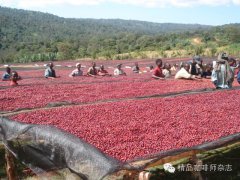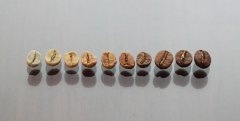The refined processing of coffee beans includes roughing, separation, classification, fermentation, drying, shelling and throwing.
Coffee bean processing
The refined processing of coffee beans has about 8 processes, such as rough processing, separation, classification, fermentation, drying, shelling, polishing, sorting and so on.
There are two ways to prepare coffee beans for the baking process. The method chosen has a significant impact on the final value and quality of coffee. The cheapest method of processing is called "drying", which is used for lower-grade coffee beans, while higher-quality coffee beans are processed by "wet treatment". Drying is used for unwashed coffee beans. Wet treatment is used for thoroughly washed or semi-washed coffee beans. Except for the more common use of drying in Brazil and Ethiopia, most Arabica coffee beans are processed by wet treatment. In Indonesia, some Robart coffee beans are processed by wet treatment, but this is not common there.

1. Drying method
Drying is the cheapest, simplest and most traditional method of processing coffee beans. When processing, the harvested fruit should be spread on the cement floor, brick floor or straw mat. Ideally, the fruits should be raked flat in the sun and at regular intervals to prevent fermentation. If it rains or the temperature drops, these fruits must be covered to prevent damage. After about 4 weeks, the water content of each fruit will drop to about 12%, when the fruit is dry. In Brazil, coffee beans at this stage are given a confusing name: coco. At this time, its skin turns dark brown and fragile, and coffee beans can be heard cackling in the shell.
The process requires more technology than it seems. Because coffee beans can be overdried, if this happens, they can easily be damaged at the next stage, when they are shelled. On the other hand, coffee beans that are not sufficiently dried are also vulnerable. The next step is to store the dried fruit in the cellar for a while. During this period, the water in fresh coffee beans continues to evaporate. In addition, easily affected by the weather, defective beans and foreign bodies are more likely to mix.
Sun-dried coffee beans
2. Wet treatment
The wet treatment process requires more capital investment and more energy, but this method helps to ensure the quality of coffee beans and reduce damage. The main difference between the wet and dry methods is that during the wet treatment, the pulp is immediately separated from the coffee beans instead of drying them.
The pulp is separated in a separator-in a machine with a fixed surface and a movable surface, or in a machine with a movable rod, the fruit is crushed so that the pulp is separated from the coffee bean. In order to ensure the quality of coffee beans, the pulp must be separated as soon as possible after harvest, which is ideal within 12 hours, but not more than 24 hours. Because, if the coffee beans are kept for too long, the pulp will become difficult to separate from the coffee beans, resulting in incomplete separation and possible damage to the coffee beans. Therefore, the coffee beans treated by wet treatment have good luster, less foreign bodies and better sour taste, but bad time treatment will produce stinky smell and special sour smell.
The peel and pulp separated from the coffee beans will be washed off with water. The flushing tank is designed to separate light and tender coffee beans from thick and ripe coffee beans. This kind of separation can also be done by the "Austrian high score machine". Ogao, a coffee grower in Norway, designed a device to filter coffee beans into a large water container while growing coffee in Kenya. The large, full beans were the first to sink into the water, while the lighter beans stayed in the large container. In this process, water can be recycled.
The next step is the most basic fermentation, that is, the use of enzymes to separate the greasy glue that covers the inner pericarp. Coffee beans are stored in a fermentor for about 12 miles for 36 hours, which is mainly determined by the ambient temperature, the thickness of the glue and the enzyme. When this process is completed, the endocarp around the coffee beans is no longer slippery but has a pebble-like feel.
In the whole wet treatment process, quality control is very important to prevent coffee tofu from rotting, because even one rotten coffee bean may damage all coffee beans. For this reason, the equipment used must be cleaned every day to ensure that no impurities are left before the next round of processing.
Fresh coffee and beans are washed and peeled off after washing.
3. Coffee beans are dried
After the wet treatment, the coffee beans are preserved in the inner pericarp so that the endocarp still contains about 15% moisture. The endocarp must be dried until the water content is about 11%, when the coffee beans are in a stable state and easy to store. Moisture content is critical. If Arabica beans are overdried to 10% water content, they will lose their original turquoise and their quality will decline.
Coffee beans covered with endocarp should be laid flat on the cement floor, slate floor, dry table or plate, which is very similar to the drying method.
In larger plantations or in places where Rain Water may disrupt the drying process, a dryer is sometimes used and the coffee beans are placed in an air-conditioning box and the dry wind blows on the surface of the coffee beans. The drying process can also be done by the sun, and coffee beans should be turned over regularly to ensure complete dryness, a process that takes 15 days. The most important thing is that the endocarp should not be cracked. If the sun is too strong, the coffee beans must be covered.
At this point, the whole process is completed, coffee beans become known as "parchment coffee beans (parchment coffee)" (because the endocarp of coffee beans is rather like parchment). In general, coffee beans are kept in this form until they are exported.
Since countries that produce coffee beans need to export coffee beans throughout the year rather than just about three months of harvest, coffee beans should be stored in the form of "parchment coffee beans" in an absolutely stable environment. High temperature is the enemy of coffee beans, and it is easy to damage coffee beans when the humidity reaches 70%. For this reason, "parchment coffee beans" are generally not stored on farms where they are produced (although there is no choice in some places). Coffee beans grown in the highlands should be stored at or near the same altitude as the places where they are grown, as they are particularly vulnerable to humidity. In this environment, Arabica coffee beans should not be stored for more than 12 hours, while Robbins coffee beans can be stored for a little longer.
4. Peeling coffee beans
The coffee beans should be ground before they are exported, that is, the endocarp of the coffee beans to be sold should be removed. The residual shell of coffee beans after removal and cleaning of endocarp and drying process is also known as peeling or peeling.
It is more difficult to remove the endocarp of coffee beans during wet treatment than during drying, so different shelling machines are needed. There are mainly two types of machines: friction sheller and compaction sheller. Engelberg and African models of friction shellers are suitable for dry or wet coffee beans: in a cylindrical box, the coffee beans are squeezed between a linear convex tone and a knife, and the shell is scraped by a knife to reveal the beans.
Parchment coffee beans are usually shelled on a Smout friction sheller. Jules Smout is a Belgian and Scottish descendant. He was born in Knesberg, Prussia, and settled in Guatemala. In 1844, he developed a coffee peeling machine with a rotating body with a screw, which rotates in a box with a screw, which rotates in the opposite direction. When the coffee bean is driven along the rotation, the endocarp is peeled off the coffee bean. Because the rotating body rotates relatively slowly, it produces less heat than other types of shelling machines.
Other shellers include rolling shellers (mainly used for dried coffee beans produced in South America) and crossbar shellers (with knives inside).
In other places except Brazil, the parchment coffee beans are treated with a pressing sheller without rubbing the sheller. Coffee beans must have moderate water content when shelling, or they may break. The pressing sheller consists of a horizontal disk rotating in a ring, and the edge of the plate is surrounded by an iron needle or rod. When the machine is running, the coffee bean comes into contact with the iron needle due to the action of centrifugal force, which makes the endocarp shell fall off.
5. Polishing coffee beans
The silver skin left on the coffee beans after shelling must be removed by polishing. Most polishers work in a similar way to Smoot shellers, except that copper rods are used instead of iron rods, which cause less damage to coffee beans, and copper can also coat coffee beans with an attractive turquoise. Coffee beans treated with a pressure sheller are usually polished because they always look more messy than those shelled by friction.
Some people think that polished coffee beans are of higher grade than unpolished coffee beans, but in fact, it makes little difference when the final drink is tasted in a cup. Others stubbornly believe that the value of polishing will be affected by the quality of the cup, but it is difficult to find conclusive evidence.
Important Notice :
前街咖啡 FrontStreet Coffee has moved to new addredd:
FrontStreet Coffee Address: 315,Donghua East Road,GuangZhou
Tel:020 38364473
- Prev

Coffee beans harvesting Coffee beans harvesting
Coffee beans are the seeds of coffee trees. After three to four years of growth, coffee trees mature and begin to bear fruit, one fruit after another arranged in clusters or clusters along the branches. The seed is covered with a peel that can be picked as soon as it turns red. Below the red skin (exocarp) is a layer of flesh (mesocarp), inside is a small thin layer, and further inside is a layer like parchment
- Next

General knowledge of coffee baking Coffee beans roast cooked beans
In this process, the roaster and cup test appraiser are the key people to control the quality of coffee. The baker is very sensitive to the changes of temperature, time and coffee beans; the mixer is familiar with the origin and characteristics of each kind of raw bean; and the Macado cup test appraiser, known as the grade appraiser, is a coffee appraiser with sensitive sense, professional knowledge and rich experience. 1. Roast coffee with raw beans
Related
- Beginners will see the "Coffee pull flower" guide!
- What is the difference between ice blog purified milk and ordinary milk coffee?
- Why is the Philippines the largest producer of crops in Liberia?
- For coffee extraction, should the fine powder be retained?
- How does extracted espresso fill pressed powder? How much strength does it take to press the powder?
- How to make jasmine cold extract coffee? Is the jasmine + latte good?
- Will this little toy really make the coffee taste better? How does Lily Drip affect coffee extraction?
- Will the action of slapping the filter cup also affect coffee extraction?
- What's the difference between powder-to-water ratio and powder-to-liquid ratio?
- What is the Ethiopian local species? What does it have to do with Heirloom native species?

